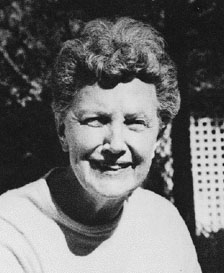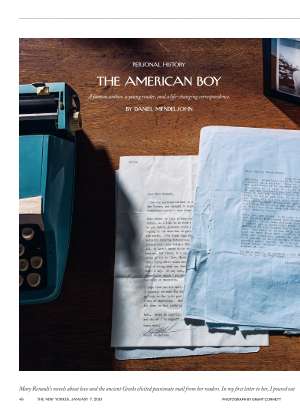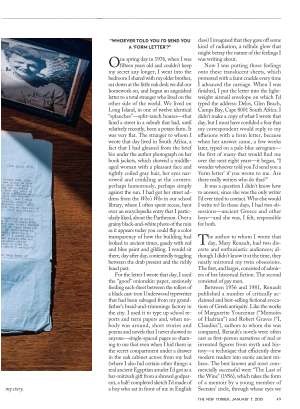Dear R,
Read more: http://www.newyorker.
I hope Christmas brought you joy and that The New Year is off to a good start.
For the last two years Nancy H (a fellow New Yorker) has kindly subscribed me to The New Yorker.
I encourage you to get hold of the current (January 7th) edition for the full version of "American Boy."
Immediately following Renault's "abstract" (below) I haved pasted the New Yorker's entire article, "Rich Man, Poor Man: The radical visions of St. Francis."
Abrazos,
Alan
PS "Argo" is a excellent suspense movie about an actual episode of American-Canadian collaboration. It begins with a couple of minutes of newsreel footage of Iranian President Mohammad Mosaddegh's democratic election, his subsequent nationalization of oil (an act most damaging to BP), and "finally" his overthrow by joint effort of CIA-MI6 --- and all the shit that's happened since. http://en.wikipedia.org/wiki/
THE AMERICAN BOY
A famous author, a young reader, and a life-changing correspondence.
BY DANIEL MENDELSOHNJANUARY 7, 2013
ABSTRACT: PERSONAL HISTORY about the writer’s early correspondence with the novelist Mary Renault. One spring day in Long Island, in 1976, when the writer was fifteen years old and couldn’t keep his secret any longer, he began an anguished letter to a total stranger who lived on the other side of the world. The author to whom he wrote that day was Mary Renault, a historical novelist who published a number of critically acclaimed and best-selling fictional evocations of Greek antiquity between 1956 and 1981. The writer’s father gave him a copy of Renault’s “Fire from Heaven” (1969) when he was twelve, and the writer was hooked. Alexander the Great was his first crush. An important narrative thread in Renault’s Alexander trilogy is the story of awakening young love—homosexual love. Reading her books, the writer felt a shock of recognition. Renault herself was a lesbian, who had emigrated from England to South Africa with her life partner, Julie Mullard, in 1948. After reading Renault’s “The Charioteer,” which is set during the Second World War and wrestles with the issue of “Greek love,” the writer wrote in his diary, “I know what I am. Now I must think what to do with it.” Describes the writer’s correspondence with Renault, which spanned eight years. The writer wrote to Renault less frequently once he started attending the University of Virginia, and even less frequently after he graduated and moved to New York City, taking a job as an assistant to an opera impresario. In December of 1983, he noticed an obituary for Renault in the Times and started crying. Twenty-five years later, in 2008, the writer received an unexpected letter from a woman in Cape Town named Nancy Gordon, who introduced herself as a friend of Renault’s and told him that Renault had often referred to him as “the American boy.” Describes his visit to Cape Town to meet some of Renault’s old friends. The writers we absorb when we’re young bind us to them. Renault showed the writer a picture of what he was, when he needed to see it, and gave him a myth that justified his fears and limitations.
***
“Why you?” a man asked Francesco di Bernardone, known to us now as St. Francis of Assisi. Francis (1181/2-1226) was scrawny and plain-looking. He wore a filthy tunic, with a piece of rope as a belt, and no shoes. While preaching, he often would dance, weep, make animal sounds, strip to his underwear, or play the zither. His black eyes sparkled. Many people regarded him as mad, or dangerous. They threw dirt at him. Women locked themselves in their houses.
Francis accepted all this serenely, and the qualities that at the beginning had marked him as an eccentric eventually made him seem holy. His words, one writer said, were “soothing, burning, and penetrating.” He had a way of “making his whole body a tongue.” Now, when he arrived in a town, church bells rang. People stole the water in which he had washed his feet; it was said to cure sick cows.
Years before he died, Francis was considered a saint, and in eight centuries he has lost none of his prestige. Apart from the Virgin Mary, he is the best known and the most honored of Catholic saints. In 1986, when Pope John Paul II organized a conference of world religious leaders to promote peace, he held it in Assisi. Francis is especially loved by partisans of leftist causes: the animal-rights movement, feminism, ecology, vegetarianism (though he was not a vegetarian). But you don’t have to be on the left to love Francis. He is the patron saint (with Catherine and Bernardino of Siena) of the nation of Italy.
Consequently, a vast number of books have been written about him. The first of the biographies appeared a few years after his death, and they’ve been coming ever since. Two more have recently appeared in English. One, “Francis of Assisi: The Life and Afterlife of a Medieval Saint” (Yale), is by André Vauchez, a professor emeritus of medieval studies at the University of Paris. The book appeared in France in 2009 and has now been published in English, in a translation by Michael F. Cusato. The other volume, “Francis of Assisi: A New Biography” (Cornell), is by Augustine Thompson, a Dominican priest and professor of history at the Dominican School of Philosophy and Theology at the Graduate Theological Union in Berkeley. The two books show that the Church is still trembling from the impact of this great reformer.
Francis came from the nouveau riche. His father, Pietro, was a successful cloth merchant in a time when the mercantile class was on the rise and clothes very much made the man. Francis went to school for only a few years, as was typical for a boy of his circumstances and sufficient for acquiring the skills a cloth merchant needed. As a teen-ager, he belonged to a gang of rowdies from prosperous Assisi families who, of a night, would eat a fine dinner, get drunk, and, in the words of Francis’s first biographer, commit “every kind of debauchery.” Francis, a high-spirited boy, was their leader and paid the bills, which made him popular. Pietro often went on business trips to France, and Francis, in time, probably went with him. On those journeys, he would have learned both French and the troubadour style of poetry, which, scholars say, infused even his most earthy writings, notably the “Canticle of Brother Sun,” said to be the first poem in the Italian language, in which he addresses the sun, the water, and the wind with humble adoration.
Francis’s world was filled with violence—between the papacy and the Holy Roman Empire, between Assisi and other towns, and, in the town itself, between the merchant class and the local nobility. It wouldn’t have been a rare day when Francis saw somebody being knifed. In 1202, around the age of twenty-one, he himself went to war, in a battle between Assisi and Perugia. He was apparently glad to go. He got to wear fine clothes and ride an excellent horse. But Assisi was soon defeated, and Francis spent a year in a dank prison, with rats, before his father was able to ransom him.
It was probably in prison that the change in Francis began. As his friends noticed, he had lost heart for revelry. Outside the city walls he found a little abandoned church, and he spent whole days there, praying. Finally, he began sleeping there as well. Pietro di Bernardone’s business, as Augustine Thompson explains it, may well have been secured by his wife’s dowry. When she died, therefore, a good chunk of the family’s holdings would go to Francis, who, if he was going to be communing with God all day, would be a poor guardian of the enterprise. When Francis was about twenty-five, Pietro took him to the town’s ecclesiastical court and explained how the young man had disregarded his responsibilities. Francis agreed with what his father said, and renounced all claims on his family. Then, we are told by early biographers, he stripped naked, placed his clothes at his father’s feet, and said that from then on God, not Pietro di Bernardone, would be his father. There is no evidence that Francis ever again conversed with his parents.
In a document called his “Testament,” written shortly before he died, Francis said that his conversion was due to his work with lepers, a number of whom lived outside Assisi. He explained, “God allowed me to begin my repentance in this way: when I lived in sin, seeing lepers was a very bitter experience for me. God himself guided me into their midst and among them I performed acts of charity. What appeared bitter to me became sweetness of the soul and body.” Lepers were horrifying to people at the time, not only because of their unsightly affliction—black boils, truncated limbs—but because the disease was thought to be caused by sin. If a leper wanted to approach a town, he had to do so at night and ring a bell to warn people of his presence. In Roberto Rossellini’s “The Flowers of St. Francis” (1950), the best of the many movies made about the saint, a leper, sounding a bell, goes past the hut where Francis and his fellows are bedded down. Francis rouses himself, catches up with the man, and embraces him. We see the leper only darkly: his blackened skin, its clammy sheen. We see Francis’s face directly, with no tears, just an ardent gaze. This is one of the most appalling and thrilling scenes in Western cinema, and it epitomizes the idea that evidently fired the young Francis. As he saw it now, the more a person was despised, the more he or she resembled Jesus in his last agonies, when he was abandoned by almost all the people he had come to save. To obey Jesus, therefore, you had to join those who were abandoned.






No comments:
Post a Comment